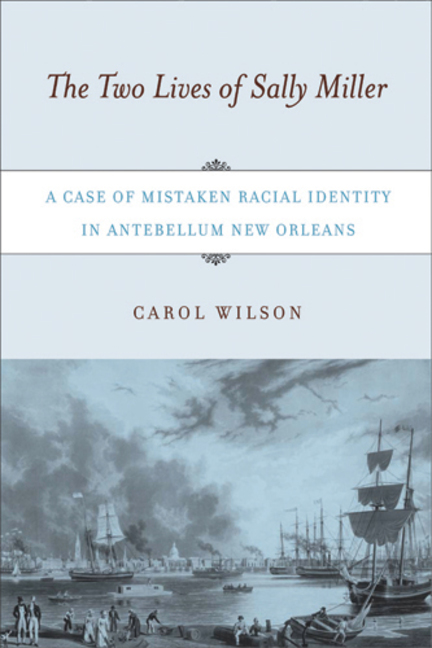The Two Lives of Sally Miller: A Case of Mistaken Racial Identity in Antebellum New Orleans |
The Two Lives of Sally Miller: A Case of Mistaken Racial Identity in Antebellum New Orleans
Rutgers University Press
2007-03-28
168 pages
9 b&w illustrations
Paper ISBN: 978-0-8135-4058-0
Cloth ISBN: 978-0-8135-4057-3
Carol Wilson, Arthur A. and Elizabeth R. Knapp Professor of American History
Washington College, Chestertown, Maryland
In 1843, the Louisiana Supreme Court heard the case of a slave named Sally Miller, who claimed to have been born a free white person in Germany. Sally, a very light-skinned slave girl working in a New Orleans cafe, might not have known she had a case were it not for a woman who recognized her as Salom Muller, with whom she had emigrated from Germany over twenty years earlier. Sally decided to sue for her freedom, and was ultimately freed, despite strong evidence contrary to her claim.
In The Two Lives of Sally Miller, Carol Wilson explores this fascinating legal case and its reflection on broader questions about race, society, and law in the antebellum South. Why did a court system known for its extreme bias against African Americans help to free a woman who was believed by many to be a black slave? Wilson explains that while the notion of white enslavement was shocking, it was easier for society to acknowledge that possibility than the alternative-an African slave who deceived whites and triumphed over the system.
Comments by Carol Wilson from her website:
Tags: Carol Wilson, New Orleans, Rutgers University Press, Sally Miller…My book on the case of Sally Miller looks at a similar issue of status. As a society we have recently begun openly acknowledging that many people in the United States are of mixed racial background. The restrictive categorization of people as either white or black has begun to collapse. Many people assume, however, that this is the result of relaxing of racial barriers over the last few decades. Scholars of pre-Civil War American history, however, are well aware of the extensiveness of racial mixing in our nation’s past, albeit a practice usually illegal and denied. Because of the not uncommon existence of enslaved mulattoes, antebellum Americans were not unused to seeing slaves who looked “white.” With racial identity a feature imposed by those in power in society, it was only a matter of time before “whites” (people of European ancestry) found themselves illegally enslaved. Because white status was impossible to prove, some whites did find themselves in slavery…
